七年级英语复习资料(上册)-推荐
新人教版七年级英语上册重点知识复习资料(全册)
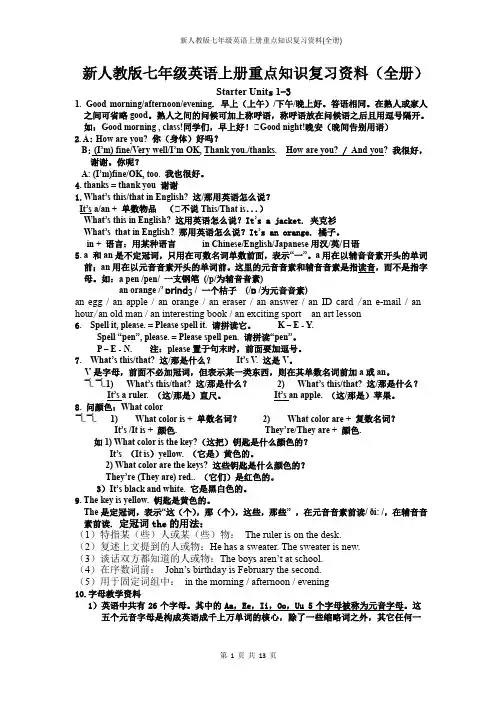
新人教版七年级英语上册重点知识复习资料(全册)Starter Unit s 1-31.Good morning/afternoon/evening. 早上(上午)/下午/晚上好。
答语相同。
在熟人或家人之间可省略good。
熟人之间的问候可加上称呼语,称呼语放在问候语之后且用逗号隔开。
如:Good morning , class!同学们,早上好!△Good night!晚安(晚间告别用语)2. A: How are you? 你(身体)好吗?B: (I’m) fine/Very well/I’m OK, Thank you./thanks.How are you? / And you?我很好,谢谢。
你呢?A: (I’m)fine/OK, too.我也很好。
4. thanks = thank you 谢谢1.What’s this/that in English? 这/那用英语怎么说?It’s a/an + 单数物品(△不说This/That is...)What’s this in English? 这用英语怎么说?It’s a jacket. 夹克衫What’s that in English?那用英语怎么说?It’s an orange. 橘子。
in + 语言:用某种语言in Chinese/English/Japanese用汉/英/日语5. a 和an是不定冠词,只用在可数名词单数前面,表示“一”。
a用在以辅音音素开头的单词前;an用在以元音音素开头的单词前。
这里的元音音素和辅音音素是指读音,而不是指字母。
如:a pen /pen/ 一支钢笔(/p/为辅音音素)an orange /’ ɒrindʒ / 一个桔子(/ɒ /为元音音素)an egg / an apple / an orange / an eraser / an answer / an ID card /an e-mail / an hour/an old man / an interesting book / an exciting sport an art lesson6. Spell it, please. = Please spell it. 请拼读它。
七年级英语总复习资料(优秀4篇)

七年级英语总复习资料(优秀4篇)七年级英语复习资料篇一语法1. 形容词的用法形容词用以修饰名词,表示人或事物的特征。
在句中可以作定语、表语,用于限定被修饰语的特征,如长短、大小、重量、颜色、高矮、胖瘦、新旧等,。
The little girl is very pretty. 这个小女孩很好看。
--I want that one. 我想要那个。
--Which one? 哪一个?--The new blue one. 那个蓝色新的。
Can I have a look at the big nice one? 我能看一看那个大的漂亮的吗?2、人称代词是用来表示人的代词,有单数和负数之分,有主格和宾格之分。
人称代词的主格在句中作主语;人称代词的宾格在句中作宾语,是作动词或介词的宾语。
主格:I, we, you, he, she, it, they在句子中作主语宾格:me, us, you, him, her, it, them在句子中作宾语He and I are in the same class. 我和他在同一个班级。
Can you see them in the street? 你能看见他们在街上吗?七年级英语复习资料篇二一般现在时一般现在时表示经常性或习惯性的动作,或表示现在的特征或状态。
其动词形式是:动词原形(只有第三人称单数作主语时除外,要加-s)其疑问句和否定句需要用助动词do或does1) 肯定句用行为动词原形表示They get up very early every morning. 他们每天早晨起来很早。
I visit my grandparents four times a month. 我一个月去看望祖父母四次。
2) 否定句用don’t + 动词原形来表示We do not go shopping on Sundays. 我们周日不去购物。
I do n’t think you like this colour. 我想你不喜欢这个颜色。
人教版七年级上册英语期末复习资料(1)
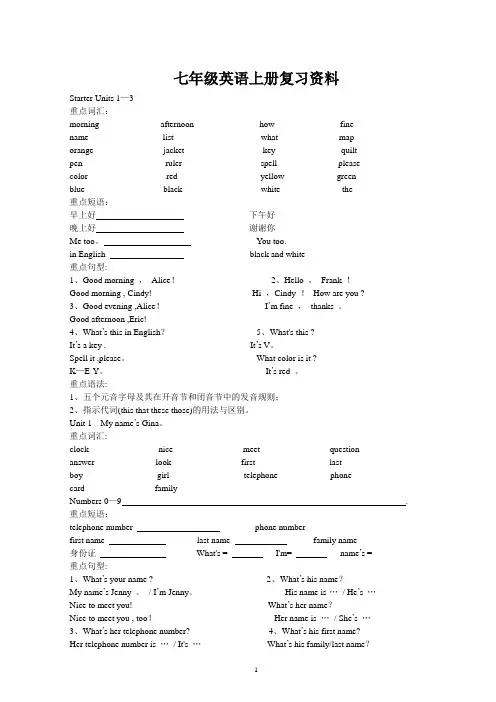
七年级英语上册复习资料Starter Units 1—3重点词汇:morning afternoon how finename list what maporange jacket key quiltpen ruler spell pleasecolor red yellow greenblue black white the重点短语:早上好下午好晚上好谢谢你Me too。
You too.in English black and white重点句型:1、Good morning ,Alice!2、Hello ,Frank !Good morning , Cindy! Hi ,Cindy !How are you ?3、Good evening ,Alice!I’m fine ,thanks 。
Good afternoon ,Eric!4、What’s this in English?5、What's this ?It’s a key . It’s V。
Spell it ,please。
What color is it ?K—E-Y。
It’s red 。
重点语法:1、五个元音字母及其在开音节和闭音节中的发音规则;2、指示代词(this that these those)的用法与区别。
Unit 1 My name’s Gina。
重点词汇:clock nice meet questionanswer look first lastboy girl telephone phonecard familyNumbers 0—9 . 重点短语:telephone number phone numberfirst name last name family name身份证What's = I'm= name’s =重点句型:1、What’s your name ?2、What’s his name?My name’s Jenny 。
七年级英语上册期中复习资料(1-4单元)
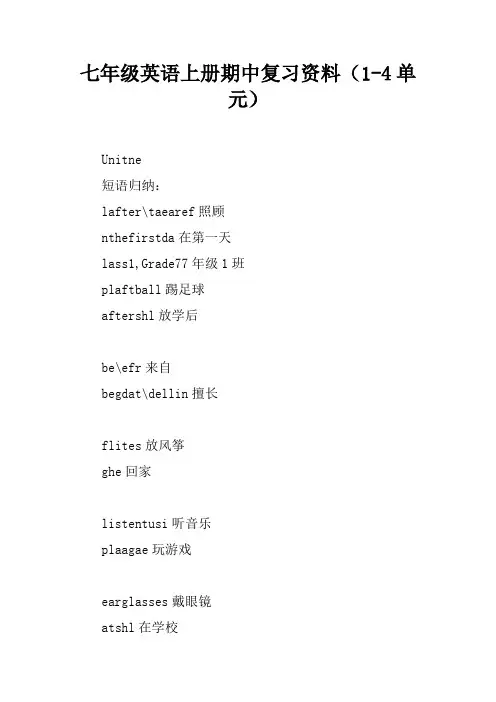
七年级英语上册期中复习资料(1-4单元)Unitne短语归纳:lafter\taearef照顾nthefirstda在第一天lass1,Grade77年级1班plaftball踢足球aftershl放学后be\efr来自begdat\dellin擅长flites放风筝ghe回家listentusi听音乐plaagae玩游戏earglasses戴眼镜atshl在学校allthelessns所有的程talabut谈论verthere那里altfhbbies许多爱好用法集萃:lve\liedingsth喜欢做某事let’s+动词原形让我们Ia\naeis我叫elet+地点欢迎来到Thisis这是begdat\dellinding擅长做inlass…Grade…在几年级几班liveith…in…和谁住在哪里I’…earld我几岁了。
Ihave…hair我留着……头发典句背诵hat’surnae?你叫什么名字?Nieteetu!很高兴见到你。
Ilvereading我喜欢阅读Nlet’seeturnelassates现在让我们认识下我们的新同学。
Iftenplaftballaftershl放学后我经常踢足球。
Sheistallandsli她个头很高,身材苗条。
HeisfrNaning他来自南京。
Heisgdataths他擅长于数学。
illieis11earsld米莉11岁。
Theareallvernie他们都很好。
Iagdatdaning我擅长于跳舞。
Unitt短语归纳:plasprts做运动antiesada一天许多次plaftball/tennis踢足球/打网球talabut谈论aftershl放学后gsiing去游泳aeberf…中的一员efr来自listentusi听音乐inthenextrldup在下届世界杯etrue实现inne’sfreetie在某人的空闲时间livein住/生活在readbs看书at/neeends=at/ntheeeend在周末staathe待在家里altf许多assbabutsth问某人某事nTV在电视上athbasetballathes看篮球比赛feelgreat感觉特棒用法集萃:hatabutdingsth?做…怎么样?Endingsth喜欢做某事aesb/sth+ad使某人/某物aesbdsth使某人做某事anttdsth想要做某事hpetdsth希望做某事havefundingsth做某事开心典句必背Iliealing我喜欢散步。
人教版七年级上册英语期末复习重点知识点解析(共十五方面)
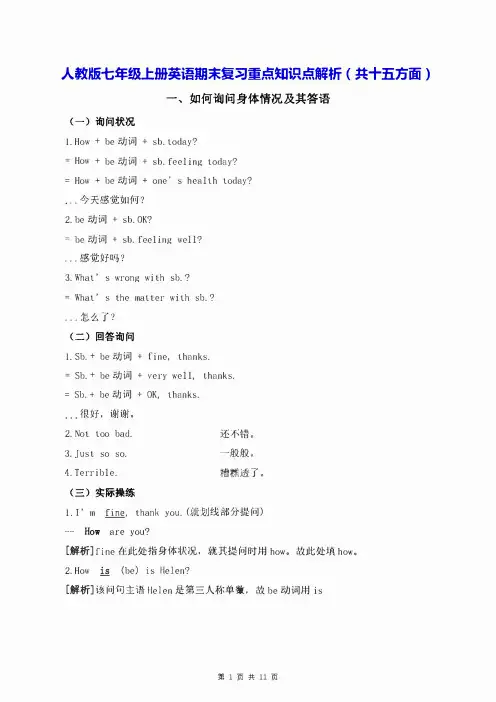
人教版七年级上册英语期末复习重点知识点解析(共十五方面)一、如何询问身体情况及其答语(一)询问状况1. H ow + be动词+sb.today?=How+ be动词+sb.feeling today?=How+ be动词+one's health today?..今天感觉如何?2. b e动词+sb.OK?= be动词+sb.feeling well?...感觉好吗?3. W hat's wrong with sb.?= W hat's the matter with sb.?...怎么了?(二)回答询问1.Sb.+ be动词+fine,thanks.= S b.+ be动词+very wel 1, thanks.= S b.+ be动词+OK,thanks.很好,谢谢。
2. N ot too bad.3.Just so so.4. T errible. (三)实际操练还不错。
一般般。
糟糕透了。
1. I'm且监,thank you.(就划线部分提问)--H ow are you?[解析]fine在此处指身体状况,就其提问时用how。
故此处填how。
2.How廷(be)is Helen?[解析]该问句主语Helen是第三人称单数,故be动词用is.、Be动词用法(一)歌谣:be动词有三个,am、is还有are;我用am,你用are,is连着他、她、它;单数名词用is,复数全部都用are。
(二)实际操练:用适当be动词填空1.I am Tony.[解析]主语为第一人称I,故后用be动词am。
2.Are you OK?[解析]该句主语为第二人称you,故be动词用are3.She is from China./ He is from China./ It is from China.[解析]此处三个句子主语均为第三人称单数,故be动词用is4.The dog is cute.[解析]该句主语t he dog为单数名词,故be动词用is5.The dogs are.cute.[解析]该句主语t he dogs为复数名词,故be动词用are三、This与that区别(一)this为指示代词,用来指代离说话人比较近的人或物that是this的对应词,用来指代离说话人比较远的人或物注意:1)回答this和that的问题时一定要用it来代替,切不可用this和that回答2) this和is不可以缩写,that和is可己缩写成that's(二)实际操练1.--What's this in English?一回答:It's a jacket.[解析]加s的回答需用口,不可以用this.2.This's a nice dog.(错误表达)This is a nice dog.(正确表达)[解析]this is不可进行缩写,故第二句子为正确表达四、颜色前是否可以有冠词a/an(一)如果"颜色”在句中作表语,则不可有冠词修饰;如果”颜色”在句中作定语,则可以有冠词修饰(二)就颜色提问时,则须用特殊疑问词组what colour(三)实际操练1. T he bag is green.[解析]此句中的green为表语,故前面不可加a/an.2. T his is a green bag.[解析]此句中的green作名词bag的定语,故前面可以有冠词a修饰3. I t's an 竺堑驻jacket.(就划线部分提问)What colour is the jacket?[解析]就颜色提问时,需要用what colour来提问,故此处为what colour五、如何询问某人的名字(一)What+be动词+人称代词+name(s)?Eg: What is her name?(二)其答语为:人称代词+name(s)+ be动词+Eg: Her name is Helen.(三)实际操练1. T heir names are Li 1�.(就划线部分提问)What are their names?[解析]提问名字时需要用what提问,故此处为what六、与first name区别:(一)last name指某人的姓;first name指某人的名;而name指某人的姓名(二)需要注意,中国姓在前名在后;而外国名在前姓在后Eg: \Vang Lingling其中\Vang为last name; Lingling为First nameEg: Jim G reen其中Green为last name; Jim为First name(三)实际操练1.Her name is Betty King.问题:What is her last name?Her last name is King.What is her first name?Her first name is Betty.[解析]Betty King为外文名词,前面为名,后面为姓。
新人教七年级英语上册单元复习资料、周末辅导(Unit3)
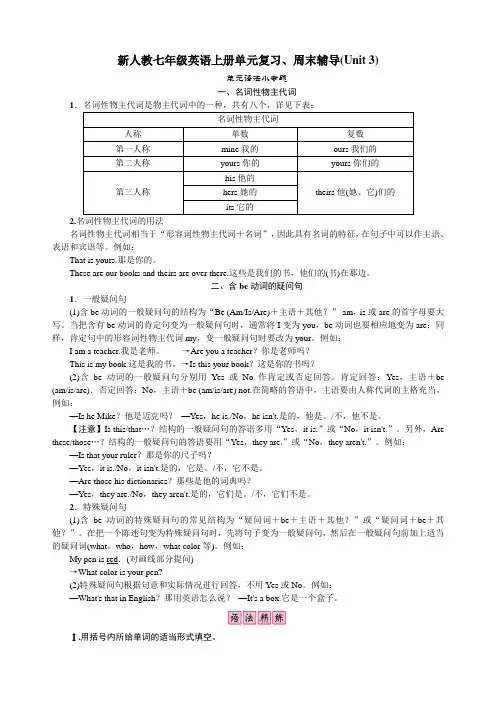
新人教七年级英语上册单元复习、周末辅导(Unit 3)单元语法小专题一、名词性物主代词1名词性物主代词人称单数复数第一人称mine我的ours我们的第二人称yours你的yours你们的第三人称his他的theirs他(她、它)们的hers她的its它的2.名词性物主代词的用法名词性物主代词相当于“形容词性物主代词+名词”,因此具有名词的特征,在句子中可以作主语、表语和宾语等。
例如:That is yours.那是你的。
These are our books and theirs are over there.这些是我们的书,他们的(书)在那边。
二、含be动词的疑问句1.一般疑问句(1)含be动词的一般疑问句的结构为“Be (Am/Is/Are)+主语+其他?” am,is或are的首字母要大写。
当把含有be动词的肯定句变为一般疑问句时,通常将I变为you,be动词也要相应地变为are;同样,肯定句中的形容词性物主代词my,变一般疑问句时要改为your。
例如:I am a teacher.我是老师。
→Are you a teacher?你是老师吗?This is my book.这是我的书。
→Is this your book?这是你的书吗?(2)含be动词的一般疑问句分别用Yes或No作肯定或否定回答。
肯定回答:Yes,主语+be (am/is/are).否定回答:No,主语+be (am/is/are) not.在简略的答语中,主语要由人称代词的主格充当。
例如:—Is he Mike?他是迈克吗?—Yes,he is./No,he isn't.是的,他是。
/不,他不是。
【注意】Is this/that…?结构的一般疑问句的答语多用“Yes,it is.”或“No,it isn't.”。
另外,Are these/those…?结构的一般疑问句的答语要用“Yes,they are.”或“No,they aren't.”。
人教版丨七年级上册英语语法专题复习(附练习题及答案)
人教版丨七年级上册英语语法专题复习(附练习题及答案)人教版丨七年级上册英语语法专题复(附练题及答案)一、一般现在时:一般现在时用于表示以下四种情况:1)现在的状态;2)经常或惯性动作;3)主语所具备的性格和能力;4)真理。
1.标志:often(经常)。
usually(通常)。
sometimes(有时)。
always(总是)。
never(从不)。
on Sundays(在星期天)。
XXX(每一天/月/年)。
2.结构:1)主语+连系动词be(am/is/are)+名词/形容词/数词/介词短语/副词等做表语表状态(包括There be +n.)。
练:1.I am a student。
My name is Tom.2.Where are my shoes。
They are here.3.Who is the girl with long straight hair。
I think she is Kate.4.You and I are not in Class Six.5.XXX。
Yes。
there is.6.XXX。
No。
they aren't.2)主语(非第三人称单数)+行为动词原形+其他(用助动词do帮助构成否定句、一般疑问句和特殊疑问)。
3)主语(第三人称单数)+行为动词的第三人称单数+其他(用助动词does帮助构成否定句、一般疑问句和特殊疑问句)。
行为动词第三人称单数加-s的形式:1.-s2.辅音+y: study-studies3.以s,x,ch,sh结尾: watch-watches。
XXX4.特殊: have-has。
do-does。
go-goes。
练:1.His parents watch TV every night.肯定句:1.XXX.否定句:2.His parents do not watch TV every night.n: My brother does not do homework every day。
(完整版)仁爱版英语七年级上复习资料
Unit 1 Making New Friends 【重点短语】1. good morning/ afternoon / evening 早上/下午/晚上好2. glad / nice to meet / see you 见到你很高兴3. welcome to + 地点欢迎来到……4. let’s + v 让我们做……5. stand up 起立6. sit down 坐下7. this is... 这是……8. thanks = thank you 谢谢9. see you = see you later = goodbye 再见10. ID number 身份证号码11. be from=come from 来自12. in English 用英语【重要句型】1. ---What’s your name? ---My name is Sally.2. ---Where are you from? ---I’m from China.---Where do you come from? ---I come from China.3. ---Where is he/ she from? ---He/She is from Japan.4. ---What’s this/ that in English? --- It’s a/ an…5. ---What’re these/ those in English? ---They’re…6. ---How do you spell it? ---E-R-A-S-E-R, eraser.7. ---Can you spell it? ---Yes, M-A-P, map.8. —How old are you/ is he/ are they?—I’m/ He is/ They are eleven.9. —What’s yourtelephone number?—It’s 4567967.10. —What class/ grade are you in?—I’m in Class Ten, Grade Seven.(注意大小写)11. Good morning/ afternoon/ evening.12. —Hello!/Hi! —Hello!/Hi!13. —Nice/Glad to see/meet you. —Nice/Glad to see/meet you, too.14. —Welcome to China/my home. —Thanks.15. —How do you do? —How do you do?16. —How are you? —Fine, thank you. And you? —I’m OK.17. —See you then/ later. —See you.18. —Goodbye. —Bye.19. —Thank you. —You’re welcome./That’s OK./Not at all.【重点语法】大小写句首字母,人名,地名,称呼语,专有名词,星期的首字母要大写,引人注意。
人教版七年级上册英语复习归纳笔记
人教版七年级上册英语复习归纳笔记掌握好七年级英语课本上的重点短语和句型,对于学好七年级英语十分重要。
以下是小编给你推荐的七年级上册英语复习归纳,希望对你有帮助!人教版七年级上册英语复习归纳Unit One list名单2.in English 用英语3.middle school中学4. last name=family name 姓氏5. first name = given name 名字6. telephone number 电话号码=phone number7. ID card 身份证8. Good morning (to sb.) 早上好9. Good afternoon 下午好10. Good night /evening . 晚上好11. my friend 我的朋友12. That’s all right. 好;行;不用谢;没关系That’s right . 对的、正确的All right . 好的,行,好吧13. Not at all.=It’s a/my pleasure. =That’s OK.=You’re welcome. =That’s all right. 不用谢Dear Lily,My full name is Kate Brown. Kate is my first name and Brown is my last name. I am a student at No. 7Middle School in Yulin. I am in Class 10,Grade 7, and I am 12 years old now. My favorite color is blue. My telephone number is 184-3546. I have a good friend at school Her name is Mary. Her phone number is 254-3975 What's your telephone number?Can you write and tell me about you?Yours,KateUnit Two1. have a good day 祝你们有愉快的一天2. in the first photo 在第一张照片中3. my cousin我的表(兄弟、姐妹)4. in the next photo 在下一张照片中5. these two girls 这两个女孩6. the name of my dog 我的狗的名字7. my family photo 我的家庭照片 = a photo of my family8. family tree 家谱9. a photo(picture) of …的一张照片Dear Rose,Here is a photo of my family.① There are ten people in my family.② These are my grandparents. And this is my father and that is my mother.③ My parents are teachers.The girl is my sister. Her name is Anna. This boy is my brother, Tom. Those are my uncle and aunt. And that boy is my cousin, Mike.I love my family.④Best wishes!⑤Yours,VeraUnit Three1. pencil box 铅笔盒2. excuse me 打扰,劳驾3. Thank you for your help. 谢谢你的帮助4.Eric’s schoolbag 艾里克的书包5.in the school library 在学校图书馆6. ask sb for sth 向某人要某物puter game(s) 电脑游戏8. a set of 一副;一套 a set of keys 一串钥匙9. call sb at+电话号码打电话给某人10. school ID card 校卡/学生证Lost:I lost a black notebook on the playground on Jan. 1st.① If you found it, please call me at 158********.②Thank you.③Lucy人教版七年级上册英语复习归纳Unit Four1. under the table 在桌子底下2. in China在中国3. come on 快点4. tape player录音机5. in his schoolbag 在他书包里6. under the bed 在床下7. on the chair 在椅子上8. under the radio 在收音机下面9.in the bookcase 在书柜里10. on the teacher’s desk 在讲台上11. on your head 在你头上12. model plane 飞机模型Look! This is my room.① It's really tidy,② There is④ a desk in my room. On the desk there are④ some books and a computer. And③ my bed is beside the desk.I like my bed very much because it's comfortable②(舒适的).Next to the bed there is a sofa.You can see a dog on the sofa. And its name is Wang wang. My room is not very big,② but③ it's very nice.② What do you think?Unit Five1. tennis ball 网球2. a ping-pong bat 乒乓拍3. at school在学校4. watch TV 看电视5. have /play/do sports 做运动6. a good idea 一个好主意7. watch a game(s) 看比赛/游戏8.That sounds interesting(fun)/good/difficult/ boring/ relaxing. 那听起来很有趣/好/困难/无聊/轻松。
人教版部编版人教版英语七年级上册知识点归纳复习
人教版部编版人教版英语七年级上册知识点归纳复习知识归纳系统,分门别类,教学过程完整,突破重难点,教学环节紧扣,学生易于接受知识,复习效果好。
七上英语各单元知识点Starter unit 11.短语归纳:good morning 早上好good afternoon 下午好good evening 晚上好name list 名单an English name 英文名字2.必背典句:(1)G ood morning! 早上好!(2)G ood afternoon! 下午好!(3)G ood evening 晚上好!3.英语中常见的问候语(1)Hello! “你好!”是比较随便、不分时间的一种问候语,通常用于打招呼、打电话。
表示惊讶或引起对方注意。
对方应答仍用Hello!(2)Hi! “你好!”的使用比hello!更随便,在年轻人中使用更为普遍。
(3)Nice to meet you! “很高兴见到你!”是两个初次见面、经介绍相识的人互相打招呼的用于。
回答时可以说Nice to meet you, too.或者Me, too.表示“见到你很高兴”(4)How do you do? “你好!”用于初次见面,是非正式的打招呼用语。
知识归纳系统,分门别类,教学过程完整,突破重难点,教学环节紧扣,学生易于接受知识,复习效果好。
对方应答语应是“Howdo you do?”(5)How are you? 表示问候How are you? 意为“你好吗?”,为询问对方身体状况的问候语,应答语一般是“I’m fine.Thank you. / I’m very well. Thank you. / I’m OK.How are you? 的其他用法:习惯上回答完别人的问候后,常可反问对方的身体状况,此时可用How are you?也可用And you? “你呢?”4.大写字母的用法:(1) 在英语中,句子的第一个单词的第一个字母都应大写。
- 1、下载文档前请自行甄别文档内容的完整性,平台不提供额外的编辑、内容补充、找答案等附加服务。
- 2、"仅部分预览"的文档,不可在线预览部分如存在完整性等问题,可反馈申请退款(可完整预览的文档不适用该条件!)。
- 3、如文档侵犯您的权益,请联系客服反馈,我们会尽快为您处理(人工客服工作时间:9:00-18:30)。
七年级英语复习资料(上册)
一、语音
1、a, an用法区别
a, an表示:一(个,张,块,条……);
当其后的单词或字母读音是以元音音素开头的,用an;这些单词前用an,eye(眼睛), hour(小时), elephant(大象), apple(苹果), American(美国人), old(老的,旧的), orange(橙子), answer(回答), actor/ actress(男/女演员), engineer(工程师), office(办公室), English(英语), England(英国,英格兰), 当其后的单词或字母读音以辅音音素开头的用:a。
其它用a.
例如:
①、There is an “m” in the word “moon”.(在“月亮”这个单词里有一个“m”)。
②、Tom has an apple.(汤姆有一个苹果) Tom has a red apple.(汤姆有一个红苹果)
2、音变
有些英语发音受后面音素影响,会发生变化。
主要有:[sk]变为:[sg],如school;[sp] 变为:[sb],如,spring;[st] 变为: [sd], 如,story。
3、读音规则:元重辅轻。
元音音素读重一点,辅音音素读轻一点。
4、符号:′表示该音节重读(读重一点),下面的表示次重读,比重读稍轻一点,有一个音节的都重读,须加。
二、语法
1、be动词用法。
①、be动词表示存在,状态;它是说明主语的状态的,一般可以翻译为“是”。
其后常常跟名词或形容词,如果跟代词必须用宾格形式。
②、be动词主要有三种形式:am, is, are. 用哪个要看主语是什么。
当主语(一般是放在句首的那个单词)是I(我)时,用am;
当主语是you(你,你们)或复数人称(we, they, these, those, the students, people 等)时用are;
当主语是第三人称单数(he, she, it, Tom, Mary, the desk, the cat, my mother 等)时用is。
2、there be 句型用法
①、there be 表示“某处有某物(人)”或“某处存在某物(人)”;
②、结构:there be +某物/人+地点(短语);
③、there be 结构的主语是be动词后面那个人或物,所以be用什么,要看后面的主语是什么。
参照be用法;
④、there be 结构的一般疑问句直接把be动词提到句首,大写,末尾用问号。
回答用:Yes, there be; No, there ben't.
3、某人有某物,用have got或has got.详见书P80.
4、some, any用法,详见书P81。
5、可数名词单数变复数,详见书P81。
6、一般现在时
①、表示存在的状态或经常性,习惯性的动作。
②、谓语动词形式:A、当主语是第三人称单数时,谓语动词用第三人称单数形式(be 动词用is,have用has其它实义动词在其后加s或者es)。
③、表频度的时间副词放在助动词(无实义,如be动词,have, do)之前,实义动词(有一个具体的动作,有意思)前;频度副词发生的概率:always(总是,一直)100%, usually (通常)90%, often(经常)60%, sometimes(有时)30%, seldom(极少)1%, never(从不,决不)0%。
④、一般疑问句,A、有be动词的,把be动词提到句首。
B、没有be动词的,借助于助动词do(或者does主语是第三人称单数时用),回答略。
7、现在进行式
①、表示说话时正在发生的动作。
②、谓语动词形式:be+V-ing;
③、动词ing形式变化规则:书上P85;
④、常用时间状语:Listen(听)! Look(看)! now(现在), at the moment(此时此刻),句子中有这些单词时就要用现在进行时。
⑤、现在进行时的一般疑问句,把be动词提到句首,末尾用问号;回答略;
三、短语
It’s time to……(该做……的时候了)goodbye=byebye=bye=see you……(再见)after school(放学后) Thank you=thanks(谢谢你) sit down(坐下) stand up(站起来) I see(我明白了) listen to(听……) in English用英语 of course(当然) welcome to……(欢迎……)what about……=How about……?(……怎么样) First name=given name (姓) last name=family name(名) on the left/right(在左/右边) next to靠近 in front of(在……前面) how many(多少) a lot of=lots of=many+much(许多,大量)have got(有,拥有) go shopping(去购物,买东西) too much(太……) be good for (对……有好处) be bad for(对……有害处) a bit(一点儿) a lot(许多,大量) get fat(变胖)go to ……(到……去) get up(起床) have breakfast/lunch/dinner(吃早、中、晚饭) such as(比如) come from=be from(来自) in the middle of(在……的中间)look at(看……) over there(在那边) a little(一点儿) as well as(像……一样) be good at(擅长,在某方面做得很好) kinds of(各种各样的……) search for (搜寻……) at weekends(在周末) hear from(收到……的来信) take photos(拍照)wait for(等待……) a few(一些,几个) on sale(正在出售) go back(回去) get off(下车) get ready for(为……作准备) put away(把……收拾好) hurry up(赶快) sweep away(扫除……) Merry Christmas(圣诞快乐).
四、单词用法区别
1、too, also(意思:也),too用于句末。
also用于句中,助动词之后,实义动词之前。
五、句型转换
1、陈述句变一般疑问句:
①、有助动词的,直接把助动词提到句首,末尾用问号?
Eg. Daming is a student.→Is Daming a student?
There are forty-two s tudents in Class 1 Grade 7.→
Are there forty-two students in Class 1 Grade 7 ?
②、没有助动词的,借助于助动词do(does),把它放在句首,其后的实义动词用原形;
Eg. Tom always gets up at 6 in the morning. →Does Tom always get up at 6 in the morning?
2、特殊疑问句:
①、结构:特殊疑问词/(短语)+ 一般疑问句?
②、特殊疑问词:what(什么,对事物,动物提问);what time(什么时间了,对时刻提问) what day is it today?(今天是星期几)what’s the date?(今天是几号) who (谁,对人提问); whose(谁的,对谁的东西,关系提问) which(哪一个,对事物或人提问) how(怎么样,对身体状态,天气,程度等提问); when(什么时候,对时间提问);where(在哪儿,对地点提问); how many/much(多少,对数量提问); how often(多久一次,对频度提问) how long(多长时间,对时间的长短提问)。
③、回答:用一个一般疑问句回答;
六、交际用语
Nice to meet you!见到你很高兴! Nice to meet! Good morning, class.同学们,早上好! Good morning, Miss Zhou!周教师,早上好!Thank you. You’re welcome! Would you like to……Yes, I would love to.
七、介词用法
at:在…(①、在具体的时刻前;(at eight(;②、在小地方school; at home) in:①在……里面(in the classroom);②在某一年,某一月(in 2000),③在某国,某洲,某市(in China);④使用 on:①在……表面(上面)(on the desk);②在具体某一天(on Wednesday);③在电脑上,在互联网上(on the computer);
八、其它
1、Let’s后跟动词原形;
2、提问:
问天气:What’s the weather like in Beijing?
问姓名:What’s your name?
问星期:What day is it today?
问日期:What’s the date today?
问年龄:How old are you? (How old is Tom?)
问来自哪儿:Where are you from?
3、时间表示法,详见书P82
九、代词。
